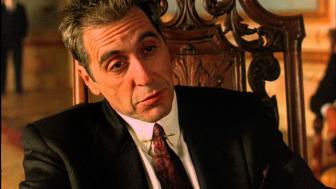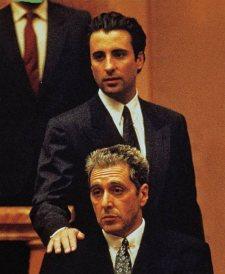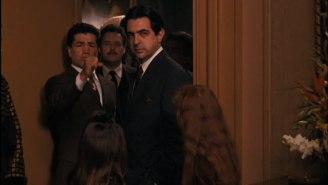
Al Pacino as Michael Corleone in The Godfather Part III (play.google.com)
More rambling than either of its illustrious predecessors, with new characters spilling forth by the minute and an unusual familial “relationship” to ponder over, Part III of Francis Ford Coppola’s Godfather trilogy is the last installment of the hit series.
His canny exploration into the inner workings of organized crime in America, with boss Michael Corleone as the chief suspect and subject, closes the circle he started with the Oscar-winning The Godfather some 16 years prior.
What took Coppola so long to complete it? Coming up with a workable story line and script for one, and money and its corrupting influence for another (and more important) reason. One of the main casualties of the prolonged negotiations was Robert Duvall as ex-consigliere Tom Hagen, who priced himself out of contention. Surprisingly enough, Coppola was unwilling to revisit these characters after his highly successful earlier projects, but Paramount Studios and its major stockholder at the time, Gulf + Western, made him (gulp!) an offer he couldn’t refuse. We should be so lucky!
An older and frailer Don Michael Corleone (the taciturn Al Pacino, in gray hair and buzz cut) tries to make good on his past promises to go straight and legitimize his lucrative Mafia dealings. In attempting to extricate himself from the Family “business,” however, Michael unwisely hands over the reins of power to a ruthless street enforcer, an onerous “clotheshorse” named Joey Zasa (oleaginous Joe Mantegna).

Andy Garcia & Al Pacino (www.tumblr.com)
When Michael’s trigger-happy nephew Vincent (Andy Garcia, in one of his best roles) comes busting in on the action, Don Corleone takes an instant liking to this, his brother Sonny’s bastard son, but is wary of the youth’s violent temper (so like his father in that respect). Further complications ensue, such as Michael’s outwardly charitable donations to and involvement with the Catholic Church, which give way to other, let’s say unforeseen, repercussions within the hierarchy of that venerable institution – in fact, all the way up to the Vatican’s banker, in a thinly veiled reference to the real-life Michele Sindona affair of the late 1970s.
There are so many red herrings, as well as false leads and dubious plot twists of fate, especially the bogus romance between Vincent’s cousin, and Michael’s daughter, Mary (an amateurish performance by Coppola’s own daughter Sofia, who became a noted filmmaker in her own right); along with son Anthony’s operatic aspirations and eventual debut as Turiddu in Mascagni’s Cavalleria Rusticana, it all gets to be a bit much after a while. Still, once all the machinations are finally set in motion, the inevitable grand finale (a truly operatic ending) materializes. It’s a humdinger of a conclusion, which may remind some cinefiles of Rod Steiger in Sidney Lumet’s harrowing The Pawnbroker.
But that Joey Zasa is a prize characterization, isn’t he, thanks to the chameleon-like Joe Mantegna (Joan of Arcadia, Criminal Minds). In addition to him, we get several new personalities, among them the creepily crooked Don Altobello (“tall and handsome”), played by short and frumpy Eli Wallach, a master of understatement; Franc D’Ambrosio (with a background in musical theater) as Anthony; the Irish-brogue-spouting Donal Donnelly as Archbishop Gilday, as devious a hoodlum priest as they come; silver-haired George Hamilton as Michael’s immaculately tailored lawyer B.J. Harrison; former middleweight boxing champion Vito Antuofermo (ugly as sin) as Zasa’s bodyguard Anthony “The Ant” Squigliaro (love that moniker!); and veteran thespian Raf Vallone as an exceptionally impressive Cardinal Lamberto, who hears Michael’s guilt-ridden confession, the movie’s emotional highpoint.

Vito Antuofermo & Joe Mantegna (nilesfilmfiles.blogspot.com)
Of the numerous returnees, Diane Keaton is her low-key self as Michael’s ex-wife Kay, whom he reconciles with during the course of the drama; sullen Talia Shire as the widowed Connie, who totes a suspect box of cannolis to the opera; Richard Bright is a much heavier Al Neri; singer Al Martino appears as singer Johnny Fontane; Gabriele Torrei is Enzo the baker (remember him as the nervous fellow who tried to light his cigarette in the first Godfather); and Jeannie Linero as Lucy Mancini, Vincent’s mother, the young bridesmaid that Sonny Corleone had, uh, up against the door in Part I (so that’s how that happened).
Directed by Coppola in high-flung fashion, with the peerless cinematography of Gordon Willis, production design by Dean Tavoularis, art direction by Alex Tavoularis, and musical direction by Carmine Coppola, Francis’ father (let’s keep it all in the family, folks). It may surprise most fans that this picture was mostly filmed in Rome’s Cinecitta Studios, also used by Martin Scorsese for his Gangs of New York. It’s not the masterpiece that everyone wanted or expected from Francis, but a worthy pretender nonetheless. Do yourself a favor and see it, if only to have your curiosity sated as to how this whole Godfather saga thingee “sorta, kinda” gets cleaned up. You’ll be thankful you did.
Copyright © 2013 by Josmar F. Lopes

